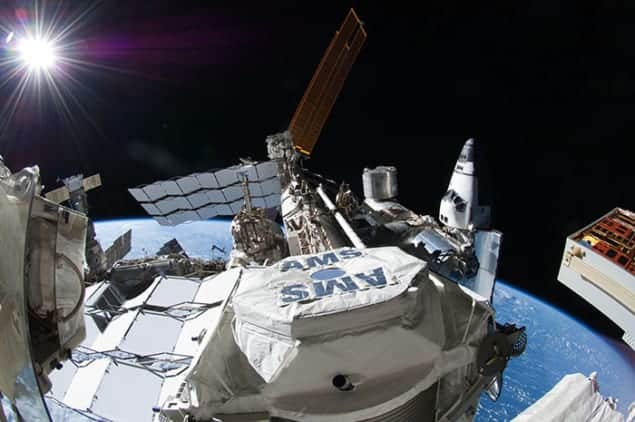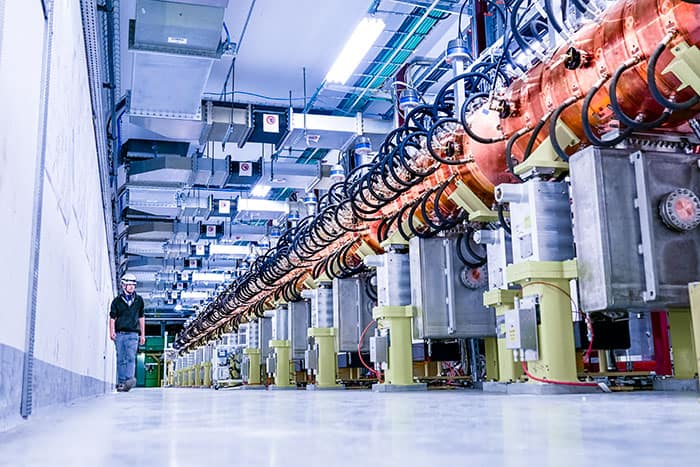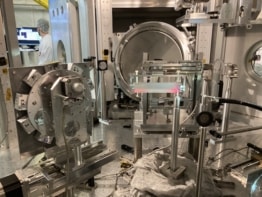Flash Physics is our daily pick of the latest need-to-know developments from the global physics community selected by Physics World‘s team of editors and reporters

Antiproton excess linked to dark matter
An unexplained excess in the number of antiprotons detected by the Alpha Magnetic Spectrometer (AMS) is related to the annihilation of dark-matter particles, according to two independent studies. Dark matter is a mysterious substance that appears to account for most of the matter in the universe. While its existence can be inferred indirectly from a number of different astronomical phenomena, dark-matter particles have never been detected directly. Writing in Physical Review Letters, Alessandro Cuoco and colleagues at RWTH Aachen University in Germany describe how they analysed antiproton, proton and helium cosmic-ray detection rates by AMS – which is located on the International Space Station – and other experiments. They found that the creation of antiprotons by the annihilation of dark-matter particles with masses of about 80 GeV/C2 provided the best explanation for why AMS has detected more antiprotons than expected to be created by conventional astrophysical process. In the same issue of the journal, Ming-Yang Cui of the Chinese Academy of Sciences and colleagues describe an independent analysis of the antiproton excess, which suggests that it is the result of annihilating dark-matter particles with masses in the 40–60 GeV/C2.
Students not choosing science despite extra activities
Science-related extracurricular activities do not encourage students to study science, technology, engineering and mathematical (STEM) subjects at high school, according to a study by Pallavi Amitava Banerjee from the University of Exeter in the UK. Banerjee tracked the educational progress of 600,000 teenagers from the start of secondary school (age 11–12) to A-level examinations (age 18). By using data from the National Pupil Database and activity providers, she examined whether students were more likely to choose STEM subjects for their A-levels if they had taken part in engagement activities such as trips to labs, special practical lessons or visits to STEM centres. Presented in Review of Education, Banerjee highlights that there is little evidence linking the two. For example, the number of students taking physics A-level was 5% for students that had taken part in enrichment activities, compared with 4.3% if they had not. On the other hand, extra activities were slightly more beneficial for children ages 11–14 rather than ages 14–16. “Of course there are many factors which can affect the decisions young people make about the subjects they choose to continue studying at age 16,” says Banerjee. “It is essential for policymakers to consider if whether, if these schemes are not working, perhaps the money could be spent elsewhere. Given the range of schemes being run it is also crucial to understand if any work better than others. Knowing the answer to this could help ensure money is spent on only the highest quality activities.”
CERN completes new linear accelerator

The CERN particle-physics lab near Geneva has built its first accelerator since the completion of the Large Hadron Collider (LHC) in 2008. Linear Accelerator 4 (Linac 4), which is around 90 m long and took a decade to construct, will be used to accelerate beams of negative hydrogen ions to 160 MeV. When Linac 4 is connected to CERN’s accelerator complex at the end of 2019, the 160 MeV beam will then be sent to the Proton Synchrotron Booster, which will accelerate the ions and strip the electrons away, before the resulting protons enter the Proton Synchrotron, the Super Proton Synchrotron and finally the LHC. Linac 4 will now undergo “extensive” commissioning and is expected to replace Linac 2, which has been in operation since 1978. The new accelerator will be part of CERN’s High Luminosity Upgrade, which will see the LHC’s luminosity increase five-fold by 2025.
Australia gains access to ESO telescopes in Chile

Astronomers in Australia will gain access to European Southern Observatory (ESO) telescopes in Chile in 2018 under a new agreement involving an A$26m payment to the ESO. Australia has also committed to the ongoing funding of the telescopes until 2028 at an average annual rate of A$12m and Australian astronomers and companies will be involved in developing new technologies for the telescopes. Chris Tinney at the University of New South Wales Sydney says: “Australian astronomers have been seeking access to ESO for the past two decades.” Lisa Kewley, who chairs the Australian Academy of Science National Committee for Astronomy, adds: “This is great news for the future of Australian astronomy.” Nobel laureate and Australian National University vice-chancellor Brian Schmidt says access to ESO’s facilities and other infrastructure such as the next-generation Giant Magellan Telescope (GMT) and Square Kilometre Array (SKA) radio telescope is critical to the future of Australian astronomy. Tim de Zeeuw, the ESO’s director general, says: “The ESO community is well aware of Australia’s outstanding instrumentation capability, including advanced adaptive optics and fibre-optic technology.” He adds: “Australia’s expertise is ideally matched to ESO’s instrumentation programme, and ESO Member State institutions would be excited to collaborate with Australian institutions and their industrial partners in consortia developing the next generation of instruments.”
- You can find all our daily Flash Physics posts in the website’s news section, as well as on Twitter and Facebook using #FlashPhysics. Tune in to physicsworld.com later today to read today’s extensive news story on how time can be reversed in emulsions.



